


Installation/Troubleshooting
Introduction
How to Use This Documentation
This product includes the following two manual types.
???Installation/Troubleshooting (this manual)
Installation/Troubleshooting provides an explanation of included accessories, a guide to initial setup and troubleshooting tips.
???Operating Instructions (included on the
Operating Instructions provides a detailed explanation of the operations, settings and functions of this product.
Abbreviations
???UPnP is the abbreviation for Universal Plug and Play.
???CATV modems and ADSL modems are referred to as modems in this manual.
???Network cameras are referred to as cameras in this manual.
Trademarks
???Ethernet is a registered trademark of Xerox Corporation in the United States and/or other countries.
???Windows is either a registered trademark or trademark of Microsoft Corporation in the United States and/or other countries.
???Screen shots reprinted with permission from Microsoft Corporation.
???All other trademarks identified herein are the property of their respective owners.
2

Installation/Troubleshooting
1 Before Using
1.1Important Safety Instructions
When using this product, basic safety precautions should always be followed to reduce the risk of fire, electric shock, or personal injury.
1.Read and understand all instructions.
2.Keep these instructions.
3.Heed all warnings.
4.Follow all instructions.
5.Do not install this product near any heat sources such as radiators, heat registers, stoves, or other apparatus (including amplifiers) that produce heat.
6.Protect the AC adaptor cord and AC cord from being walked on or pinched particularly at plugs, convenience receptacles, and the point where they exit from this product.
7.The AC cord is used as the main disconnect device, ensure that the AC outlet is located/installed near the product and is easily accessible.
8.Use only the included Panasonic AC adaptor and AC cord.
9.The AC adaptor must remain connected at all times. (It is normal for the adaptor to feel warm during use.)
10.To prevent the risk of fire or electrical shock, do not expose this product to rain or any type of moisture.
11.Do not touch the product or the AC adaptor and AC cord during lightning storms.
12.Unplug this product when unused for a long period of time.
13.Refer all servicing to qualified service personnel. Servicing is required when this product has been damaged in any way, such as when the AC adaptor, AC cord or plug is damaged, this product does not operate normally, or it has been dropped.
SAVE THESE INSTRUCTIONS

Installation/Troubleshooting
1.1.1FCC and Other Information
This equipment has been tested and found to comply with the limits for a Class B digital device, pursuant to Part 15 of the FCC Rules. These limits are designed to provide reasonable protection against harmful interference in a residential installation. This equipment generates, uses, and can radiate radio frequency energy and, if not installed and used in accordance with the instructions, may cause harmful interference to radio communications. However, there is no guarantee that interference will not occur in a particular installation. If this equipment does cause harmful interference to radio or television reception, which can be determined by turning the equipment off and on, the user is encouraged to try to correct the interference by one or more of the following measures:
This product operates at frequencies that may cause interference to nearby TVs and VCRs. To minimize or prevent such interference, the base of this product should not be placed near or on top of a TV or VCR. If interference is experienced, move this product further away from the TV or VCR. This will often reduce or eliminate interference. Operating near 2.4 GHz electrical appliances may cause interference. Move away from the electrical appliances.
???Environment ??? do not place the product in a room where the temperature is less than 0 ??C (+32 ??F) or greater than +40 ??C (104 ??F). Allow 10 cm (4 inches) clearance around the product for proper ventilation.
Avoid excessive smoke, dust, mechanical vibration, shock, or direct sunlight.
???Routine care ??? wipe the product with a soft cloth. Do not use benzine, thinner, or any abrasive powder. When you leave the product unused for a long period of time, unplug the AC cord plug from the outlet.
???If there is any trouble ??? consult an authorized Panasonic Factory Service Center.
FCC RF Exposure Warning:
???To comply with FCC RF exposure requirements in uncontrolled environment:
???This equipment must be installed and operated in accordance with provided instructions and a minimum 20 cm (8 inches) spacing must be provided between antenna and all person's body (excluding extremities of hands, wrist and feet) during wireless modes of operation.
???This transmitter must not be
???Medical
Consult the manufacturer of any personal medical devices, such as pacemakers, to determine if they are adequately shielded from external RF (radio frequency) energy. (The product operates in the frequency range of 2400 MHz to 2483.5 MHz, and the power output level is 0.1 watts.) Do not use the product in health care facilities if any regulations posted in the area instruct you not to do so. Hospitals or health care facilities may be using equipment that could be sensitive to external RF (radio frequency) energy.
???Any changes or modifications not expressly approved by the party responsible for compliance could void the user's authority to operate this device.
4

Installation/Troubleshooting
This device complies with Part 15 of the FCC Rules. Operation is subject to the following two conditions: (1) This device may not cause harmful interference, and (2) this device must accept any interference received, including interference that may cause undesired operation.
Responsible Party: Panasonic Corporation of North America
One Panasonic Way
Secaucus, NJ 07094
Tel No:
No responsibility will be taken by our company with respect to consequences resulting from the use and/or the damage of the Network Camera Management System.

Installation/Troubleshooting
1.1.2Security Cautions
When using this product, take appropriate measures to avoid the following security breaches.
???Leaks of private information via this product
???Illegal use of this product by a third party
???Interference or suspension of the use of this product by a third party
Take the following measures to avoid security breaches:
???To prevent illegal access, keep the update firmware (If you do not have the latest version of firmware, this can lead to blocked access or information leaks).
???When downloading data from the Internet, ensure that viruses or illegal programs or not inadvertently downloaded.
???You are responsible for the security settings, such as user name and password, to access this product. This information should not be made available to any third parties outside the user group.
???Place this product where it is unlikely to be stolen.
???You are responsible for this product's user information, such as videos, still images and internet contents etc. This information should not be made available to any third parties outside the user group.
???When sending this product to be repaired with a company not related to Panasonic, make
???When transferring this product to another party, make
???When disposing of this product, reset this product to factory default, or erase information by means of electrical deletion or physical dismantlement.
Panasonic Communications Co., Ltd.
1.1.3Open Source Software
Parts of this product use Open Source Software supplied based on the conditions of the Free Software Foundation's GPLs and/or LGPLs and other conditions. Relevant conditions apply to this software. Therefore, please read gpl.txt and lgpl.txt in the license folder in the open_source folder on the included
For inquiries regarding the contents above, see http://panasonic.co.jp/pcc/products/en/netwkcam/. Enter the necessary firmware information on the Inquiry form and submit it.
6
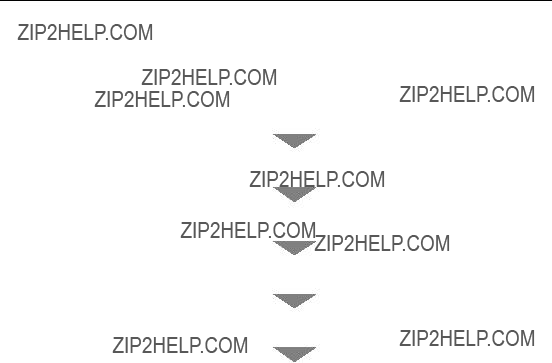
Installation/Troubleshooting
2 Installation
2.1From Start to Finish
Notes
???Steps 1 to 5 are explained in this manual.
???Steps 6 is explained in Operating Instructions on the
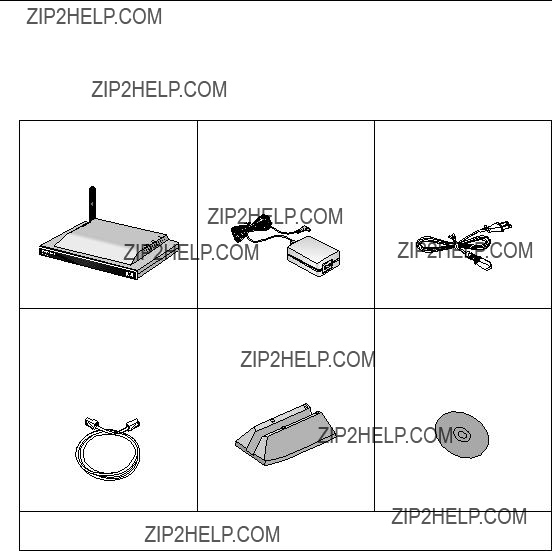
Installation/Troubleshooting
2.2Check the Accessories
Main Unit and Included Accessories
The following items are provided with this product. Additional pieces can be ordered by calling
???Installation/Troubleshooting (this manual) - 1 pc.
???Warranty - 1 pc.
Accessories to be Provided by Customer
???Ethernet Cable (category 5 straight cable) - 1 pc.
???Network Camera
???PC
8
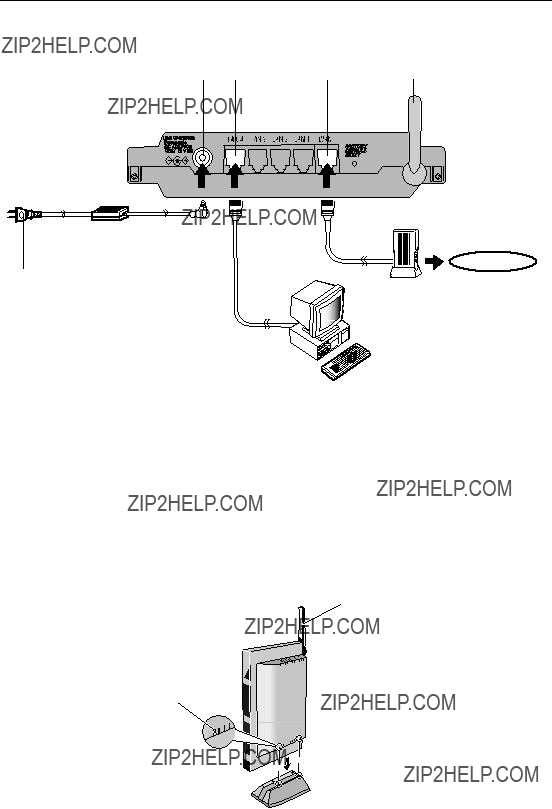
Installation/Troubleshooting
2.3Connect This Product
5.
Internet
Modem
PC
1.Raise the antenna.
2.Connect the modem to this product's WAN jack.
3.Connect the PC to this product's LAN jack.
4.Insert the AC adaptor cord into the DC IN jack of this product.
5.Insert the AC cord into the AC adaptor socket and the plug into an outlet. (This product will be turned on automatically.)
When using the stand
2. Align the first groove of this product with
1.Raise the antenna.
Adjust the antenna to the vertical position
the stand and insert.
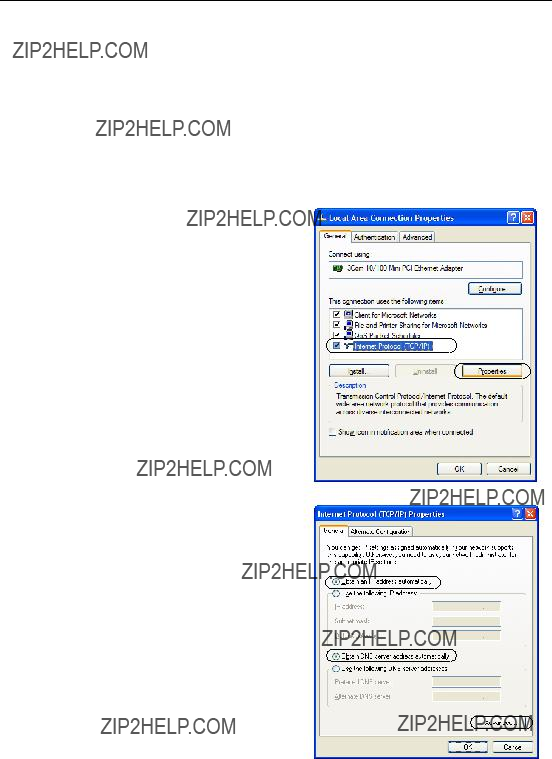
Installation/Troubleshooting
2.4Set Up the PC
Using Windows?? XP
It is necessary to log in as the administrator to change the settings on Windows XP.
1.From the Start menu, select My Computer, My Network Places and then View network connections.
2.
3.Select Internet Protocol (TCP/IP), and click [Properties].
4.
5.
Click [Advanced...].
Check that the Default gateways field is empty, and click [OK].
???If an IP address is entered in the field, select it and click [Remove].
6.Select Obtain an IP address automatically and also select Obtain DNS server address automatically, and click [OK].
7.Click [Close] and close the Local Area Connection Properties window.
10
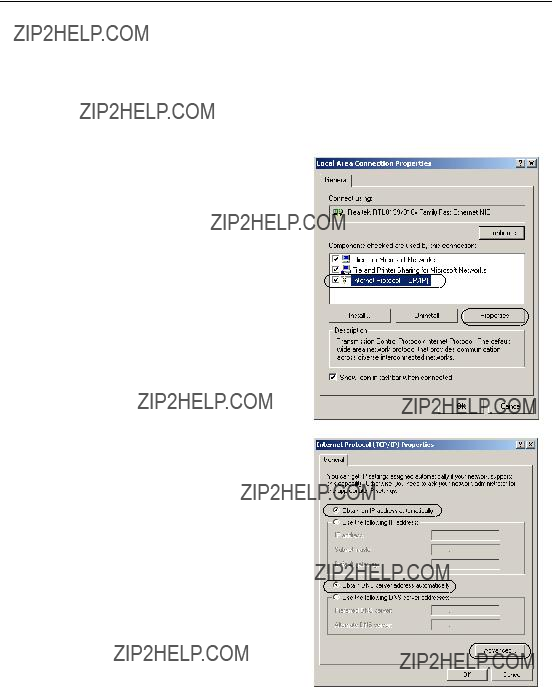
Installation/Troubleshooting
Using Windows 2000
It is necessary to log in as the administrator to change the settings on Windows 2000.
1.
2.
3.Select Internet Protocol (TCP/IP) and click [Properties].
4.
5.
Click [Advanced...].
Check that the Default gateways field is empty and click [OK].
???If an IP address is entered in the field, select it and click [Remove].
6.Select Obtain an IP address automatically and also select Obtain DNS server address automatically, and click [OK].
7.Click [OK] and close the Local Area Connection Properties window.
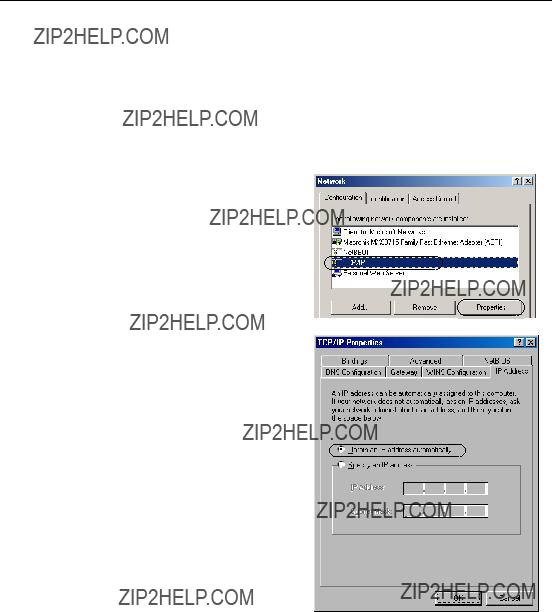
Installation/Troubleshooting
Using Windows Me/98SE
1.From the Start menu, select Settings and click Control Panel.
2.
???If you cannot find the Network icon when using Windows Me/98SE, click Display All Control Panel Applications.
3.Select a TCP/IP compatible with the LAN card, and click [Properties] in the Network dialog box.
4.Click the IP Address tab and select Obtain an IP address automatically.
5.Click the Gateway tab and check that the Installed Gateway field is empty.
???If an IP address is entered in the field, select it and click [Remove].
12

Installation/Troubleshooting
6.Click the DNS Configuration tab, select Disable DNS, and click [OK].
7.Click [Yes] and restart the PC.
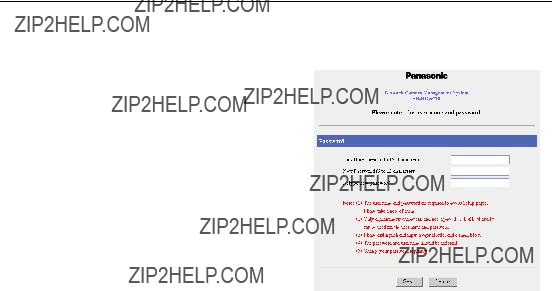
Installation/Troubleshooting
2.5Register an ISP and Connect to the Internet
1.Start up the web browser.
2.Enter "http://bbhgw.webpage:8080" into the web browser's address bar (the default port number is 8080).
???The user name and password window is displayed.
3.Enter New User Name, New Password, and Retype New Password and click [Save].
??? The top page is displayed.
Notes
???It is important to always use your user name and password for authentication when using this product.
???Access information (user name/password), this product's setup information, application setup information, logs and other system management information is the responsibility of the customer. Access to this information should be limited to users or user groups, and third parties should not be allowed to refer to, modify, delete or copy this information. Information such as user name, password, setup and management information should be kept confidential.
14

Installation/Troubleshooting
4.Click Setup.
Setup
Camera Portal
Notes
???In the default settings, it is possible to display the top page by entering "http://192.168.0.254:8080" into the web browser's address bar.
???When accessing Setup from the top page, an authentication window is displayed (after starting the web browser, first time only). Log in by entering your user name and password and clicking [OK].
???In order to view the camera images on the Camera Portal page of this product, it is necessary to have completed a connection with a compatible camera
.
If the top page is not displayed...
???Confirm that "http://bbhgw.webpage:8080" is entered correctly in the address bar (the default port number is 8080). If the address is correct and the top page is still not displayed enter "http://192.168.0.254:8080".
???Confirm that the LAN indicator corresponding to the jack connected to this product is on.
???Confirm that the this product's power was turned on before the PC's power was.
???Sometimes it is necessary to set up the web browser's proxy server to access the top page (see page 122 of Operating Instructions on the

Installation/Troubleshooting
5.Register an ISP
The ISP registration page allows you to register new ISPs for this product, edit them, and delete them. Internet connection methods vary according to the ISP. Select a connection method referring to the ISP's setup information.
Consult with your contracted ISP about which connection type to use, or about your service or contract.
Data Entry Field
*If it is not necessary to enter information into the data entry field, leave it blank.
16
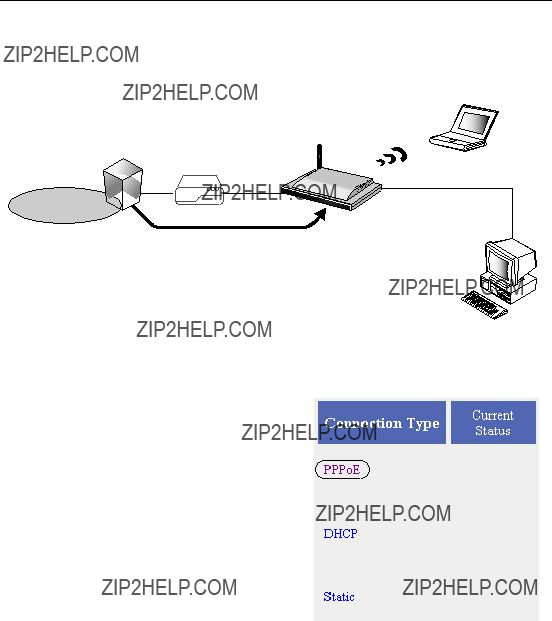
Installation/Troubleshooting
PPPoE Connection
Follow the steps below to set up PPPoE connection.
Private address 192.168.0.2
ISP
Modem
Internet
The ISP assigns an IP address by PPPoE connection.
Private address 192.168.0.1
1.
2.
3.
Select [ISP Registration].
Click [Register/Edit] on the ISP registration list.
Select PPPoE.
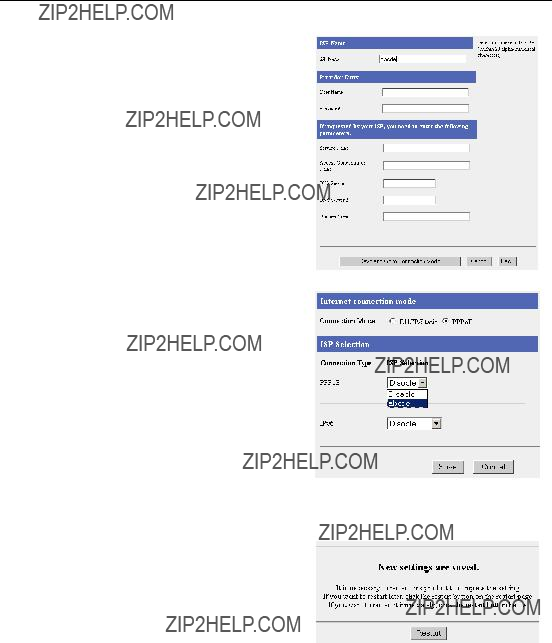
Installation/Troubleshooting
4.Enter ISP Name.
???Enter no more than 20 characters. In the example right, "abcde" has been entered.
5.Enter User Name and Password, and if specified by the ISP, enter Service Name, Access Concentrator Name, DNS Server 1, 2, and/or Domain Name.
???See the ISP's setup information. To return to the original settings, click [Cancel].
6.When setup is complete, click [Save and Go to Connection Mode].
??? The connection mode page is displayed.
7.
8.
Select the ISP entered in step 4.
When setup is complete, click [Save].
???The entered information is saved.
Note
When saving, do not cut the power supply. If cut, saving might not be completed successfully.
9.When [Restart] is displayed on the setup page, click it.
10.Restart the PC.
???Check that the PC is connected to the Internet.
Notes
???When registering or editing, restart all PCs connected to the LAN (home) side.
???When adding more PCs after setup has been completed, connect the new PCs to jacks LAN1 to LAN4 and then restart.
???When instructed by your ISP, change the MTU value. When not instructed, leave it as the default (1492).
18
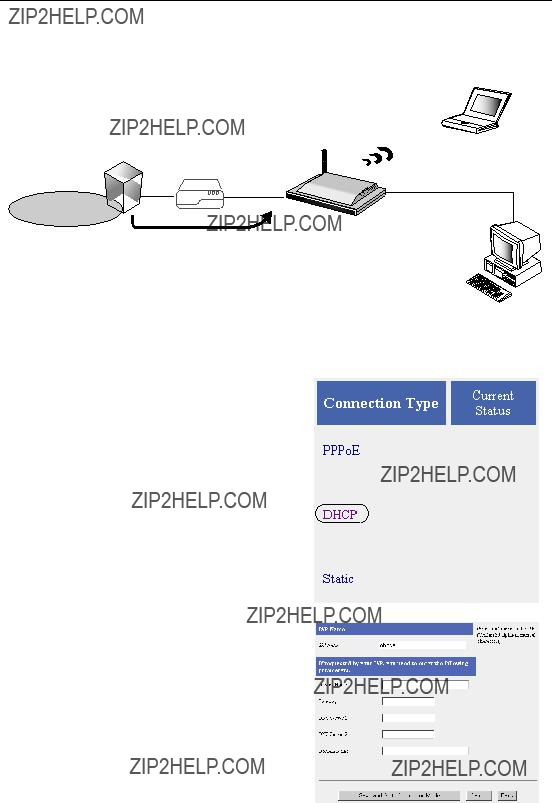
Installation/Troubleshooting
DHCP Connection (Internet Connection using a DHCP Server)
Follow the steps below to set up DHCP connection, where an IP address is automatically allocated by the ISP.
ISP
Modem
Internet
The ISP's DHCP Server assigns an IP address.
1.Select [ISP Registration].
2.Click [Register/Edit] on the ISP registration list.
3.Select DHCP.
Private address 192.168.0.2
Private address 192.168.0.1
4.Enter ISP Name.
???Enter no more than 20 characters. In the example right, "abcde" has been entered.
5.If specified by the ISP, enter Device Name*, Gateway, DNS Server 1, 2, and/or Domain Name.
???See the ISP's setup information. To return to the original settings, click [Cancel].
*The device name is sometimes said by the ISP to be the ID entered into the PC's Computer Name entry field.

Installation/Troubleshooting
6.When setup is complete, click [Save and Go to Connection Mode].
???The connection mode page is displayed.
7.Select the ISP entered in step 4.
8.When setup is complete, click [Save].
???The entered information is saved.
Note
When saving, do not cut the power supply. If cut, saving might not be completed successfully.
9.When [Restart] is displayed on the setup page, click it.
10.Restart the PC.
???Check that the PC is connected to the Internet.
Notes
???When registering or editing, restart all PCs connected to the LAN (home) side.
???When adding more PCs after setup has been completed, connect the new PCs to jacks LAN1 to LAN4 and then restart.
20
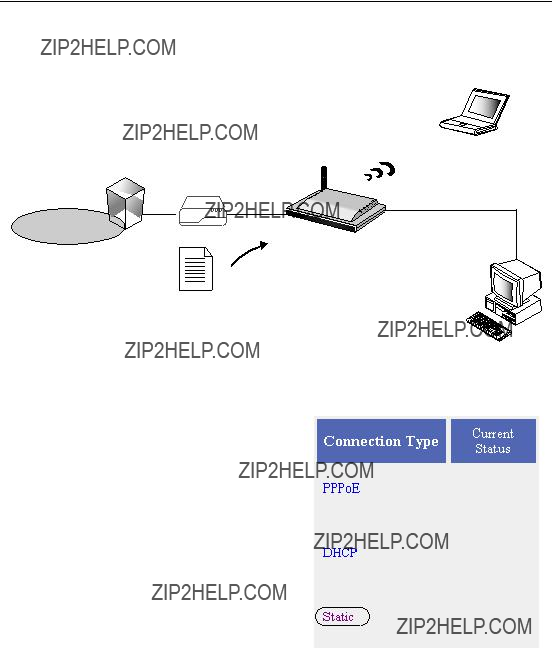
Installation/Troubleshooting
Static Connection (Internet Connection using a Static IP Address)
It may be necessary, if you are instructed by the ISP, to enter the value of the IP address or gateway address into setup information.
ISP
Private address 192.168.0.2
Modem
Internet
Static IP Address
An IP address is set based on information from the ISP.
Private address 192.168.0.1
1.
2.
3.
Select [ISP Registration].
Click [Register/Edit] on the ISP registration list.
Select Static.
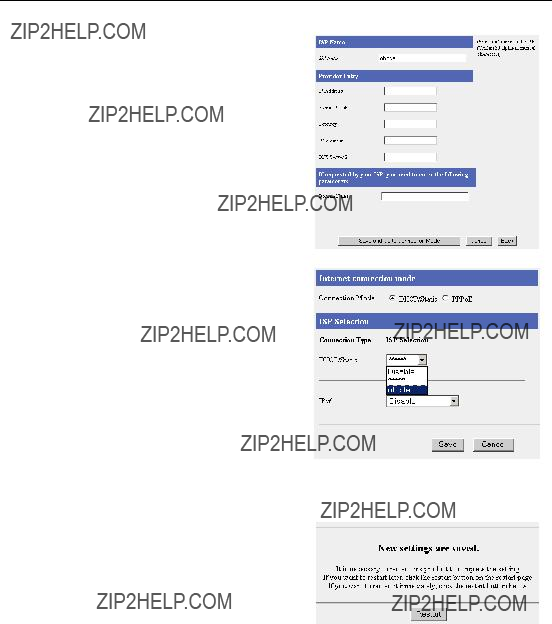
Installation/Troubleshooting
4.Enter ISP Name.
???Enter no more than 20 characters. In the example right, "abcde" has been entered.
5.Enter the IP Address, Subnet Mask, Gateway and DNS server 1, 2, and if specified by the ISP, enter the Domain Name.
???See the ISP's setup information. To return to the original settings, click [Cancel].
6.When setup is complete, click [Save and Go to Connection Mode].
??? The connection mode page is displayed.
7.
8.
Select the ISP entered in step 4.
When setup is complete, click [Save].
???The entered information is saved.
Note
When saving, do not cut the power supply. If cut, saving might not be completed successfully.
9.When [Restart] is displayed on the setup page, click it.
10.Restart the PC.
???Check that the PC is connected to the Internet.
Notes
???When registering or editing, restart all PCs connected to the LAN (home) side.
???When adding more PCs after setup has been completed, connect the new PCs to jacks LAN1 to LAN4 and then restart.
22
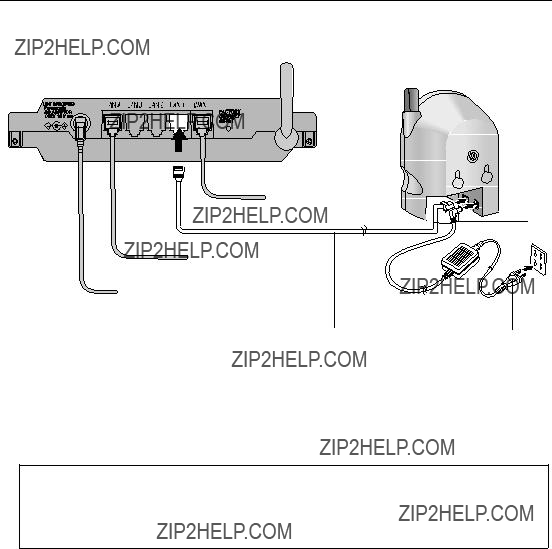
Installation/Troubleshooting
2.6Connect a Network Camera

 To the modem
To the modem
2.

 To the PC
To the PC

 To the outlet
To the outlet
1.3.
1.Connect the Ethernet cable between the camera and the LAN jack of the router.
2.Insert the AC adaptor cord into the DC IN jack of the camera.
3.Insert the AC cord into the AC adaptor socket and the plug into an outlet (The camera will be turned on automatically.)
Camera Automatic Setup
If a Panasonic Network Camera
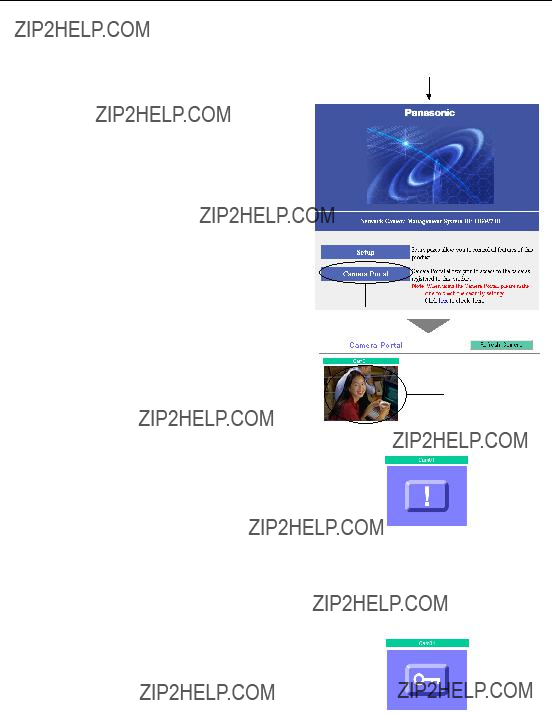
Installation/Troubleshooting
4.Check the connection.
1)To display the top page of this product start up the web browser, enter "http:// bbhgw.webpage:8080" into the address bar, and press [Enter].
???In standard settings, if you enter "http:/ /192.168.0.254:8080" into the web browser's address bar, the top page will be displayed.
2)Check that the camera indicator is shining green and click [Camera Portal].
3)Click a camera frame on the camera portal page, access the camera, and check that it is connected.
???If a single camera page is displayed, setup is completed.
1) Enter "http://bbhgw.webpage:8080".
2) Click here.
3) Click here.
???If an exclamation mark is displayed, click it and the camera's password window is displayed. Perform the settings on each page. Setting Allow Access from the Internet to Enable, displays the camera images on the Camera Portal over the Internet. Setting Disable only displays the camera images on the Camera Portal when accessing from the LAN side.
(It is displayed when a factory default camera is connected.)
???If a key mark is displayed, click it and enter that camera's user name and password.
(If camera authentication has been set up, the key mark will be displayed.)
24

Installation/Troubleshooting
???A blue unmarked window is displayed when the camera is outside operation time. If a blue unmarked window is displayed even when the camera is operating, click [Refresh Camera].
(A blue unmarked window may be displayed when authentication is being confirmed.)
???If the camera and this product are disconnected while sending or receiving data, a key mark (when camera authentication is set up) or a blue unmarked window is displayed. In this case, after checking that the camera's power supply and connections are correctly inserted, click [Refresh Camera].
5.Install the camera
???See the Operating Instructions of each camera for details of how to install the camera.
???When using a wireless camera, remove the AC adaptor from the outlet, remove the Ethernet cable, and install the camera in the wireless mode.
???See page 39 in Operating Instructions on the

Installation/Troubleshooting
3 Troubleshooting
Checking Connection
26

Installation/Troubleshooting
28

Installation/Troubleshooting
30
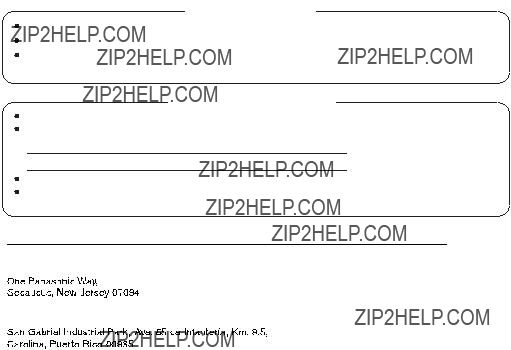
For product service
Panasonic Servicenters are listed in the servicenter directory. Call
This product is designed for use in the United States of America. Sale or use of this product in other countries/areas may violate local laws.
When you ship the product
Carefully pack your unit, preferably in the original carton.
Attach a letter, detailing the problem, to the outside of the carton.
Symptom
Send the unit to an authorized servicenter, prepaid and adequately insured.
Do not send your unit to the Panasonic Consumer Electronics Company listed below or to executive or regional sales offices. These locations do not repair consumer products.
The information in this document is subject to change without notice.
Panasonic Consumer Electronics Company,
Division of Panasonic Corporation of North America
Panasonic Puerto Rico, Inc.
Copyright:
This material is copyrighted by Panasonic Communications Co., Ltd., and may be reproduced for internal use only. All other reproduction, in whole or in part, is prohibited without the written consent of Panasonic Communications Co., Ltd.
 2004 Panasonic Communications Co., Ltd. All Rights Reserved.
2004 Panasonic Communications Co., Ltd. All Rights Reserved.